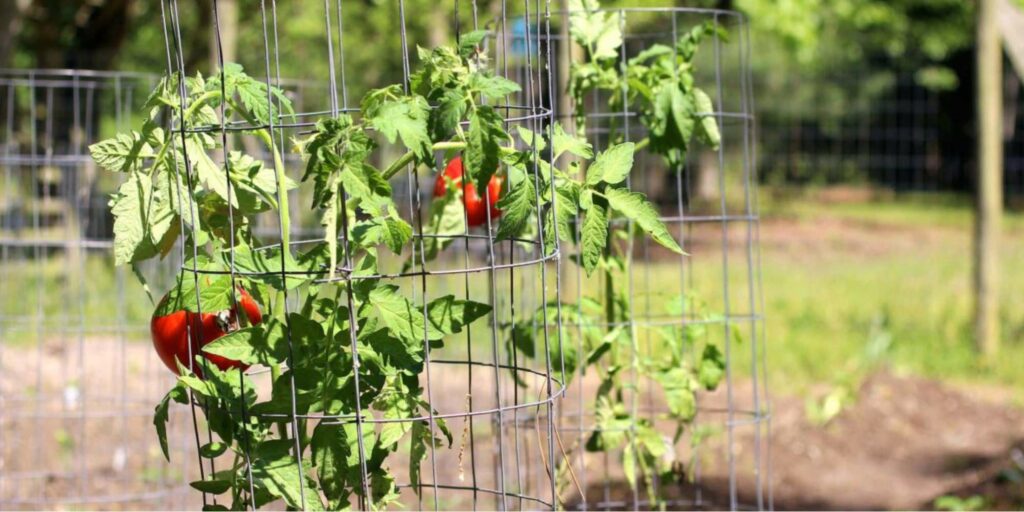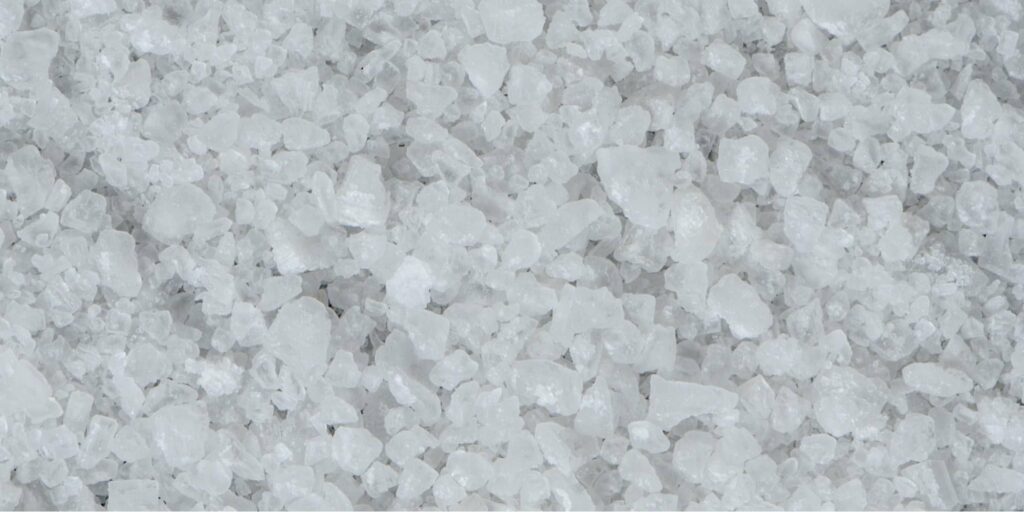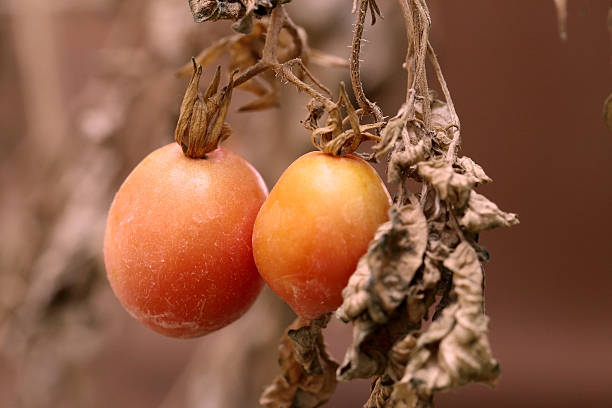
When we see our tomato leaves turn brown, this can be traumatic especially when we have been dutifully caring for them.
We’ll look into the multiple reasons that can cause tomato leaves to turn brown and the ways we can resolve the situation.
Why are the leaves on my tomato plant turning brown?
There are 11 possible reasons for tomato leaves curling. These are:
- Natural leaf turnover
- Plant damage
- Underwatering
- Overfertilization
- Contaminated soil
- Tomato Russet mite
- Bacterial leaf spot
- Canker
- Verticillium wilt
- Early blight
- Late blight
Let’s go into each of these reasons in more detail.
1. Natural Leaf Turnover
The simplest reason could be the most probable: your tomato plant is getting rid of its old leaves. Tomato leaves shed off mature leaves from time to time, and they naturally manifest as brown leaves.
How You Can Solve It: Leave It Be
For natural leaf turnover:
- Inspect the brown leaves for signs of any damage, pests, or unnatural causes.
- Prune off the old brown leaves once you have determined that the cause is natural.
- Dispose of the brown leaves safely.
2. Plant Damage
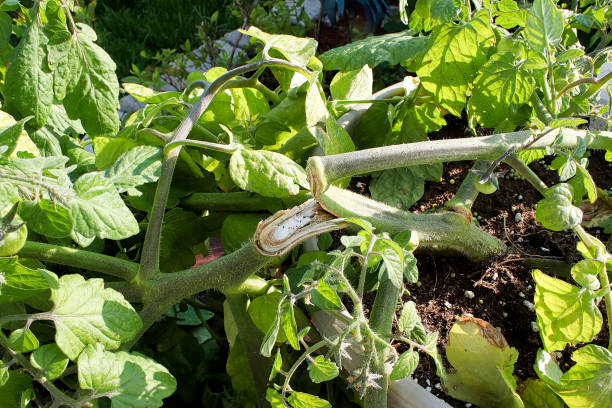
Tomato plants can get damaged from time to time. The cause could be accidental, strong winds, lack of support, or even curious animals.
The plants display brown leaves as a result of damage from broken stalks and stems.
How You Can Solve It: Prune and Trim
For pruning and trimming brown tomato leaves:
- Clean and sterilize your pruning shears, gloves, and other gardening tools.
- Snip off the damaged parts, including any large stalks.
- Dispose of the pruned tomato plant parts safely.
3. Underwatering
When your tomato plant receives very little water or is dehydrated, its leaves start to curl up and turn brown. When this happens, it is a sign that your plant needs to be watered.
How You Can Solve It: Water Correctly
For underwatered tomato plants:
- Move the dehydrated plant into partially shaded areas. For in-ground plants, cover with a protective netting from the sun.
- Provide your plant with the right amount of water.
- Monitor your plant to check its health.
- Return the potted plant to its original location or remove the protective covering from in-ground plants.
4. Overfertilization
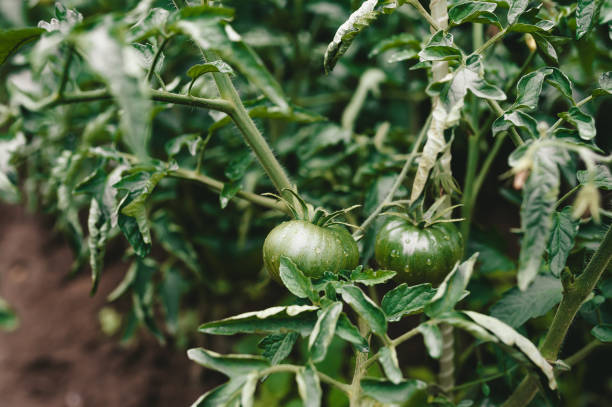
 Image on istockphoto.com by IRINA KAZLOVA
Image on istockphoto.com by IRINA KAZLOVAFertilizers help plants grow to be healthy productive specimens. However, when the dose is too strong or applied too frequently, the plant can suffer from chemical burns.
This also means that the soil contains too much fertilizers that can cause further harm to its roots.
How You Can Solve It: Flush with Water
How to flush away fertilizers:
- Water the soil thoroughly to ensure that excess fertilizer is drained off.
- Another option is to replant your tomato, although you have to ensure it doesn’t experience transplant shock
5. Contaminated Soil
The root system of the tomato plant is sensitive to chemicals, both beneficial and toxic. Toxic chemicals include petroleum products, acids, alkaline products, and other unwanted chemicals.
When absorbed by the root system, your tomato plant can go into shock. The result can be in the form of curling brown leaves.
How You Can Solve It: Replace Soil or Relocate Plants
How to replace your garden soil:
- Remove the affected plants from the suspected contaminated area.
- Identify the extent of the contaminated soil.
- Do a soil test to determine the spread and depth of the contamination.
- Depending on the gravity of the situation, you can either dig up the affected area if it is manageable or hire a contractor to dig up the soil if the area is too large.
- Dispose of the contaminated soil safely.
- Bring in new garden soil, mix in some compost, and shovel in your new soil.
How to relocate your tomato plants:
- Identify if your plants can still be transplanted without going into shock.
- Since seedlings and potted tomato plants are easier to relocate, place them away from the contaminated soil.
- For in-ground tomato plants, it may be almost next to impossible to save them if they have been exposed to strong chemicals in contaminated ground. Simply allow them to die off and plant new ones in your new garden soil.
6. Tomato Russet Mite
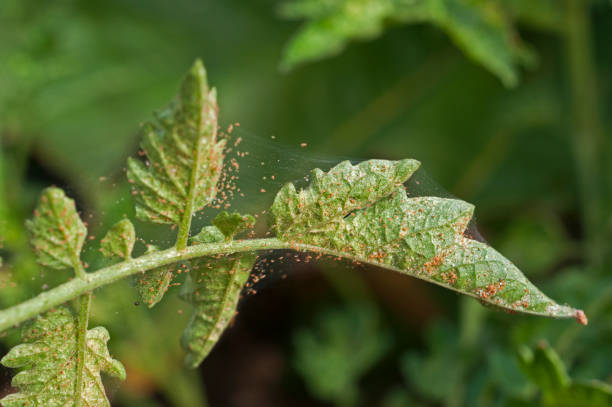
The presence of strange brown specks on your vibrant green tomato leaves signal tomato Russet mites. If you’re still doubtful, thin white webbing will confirm your suspicions.
You can find them on the undersides of leaves sucking hungrily on the leaf sap. This causes your tomato leaves to turn reddish brown before dying off.
How You Can Solve It: Spray Down
How to control tomato Russet mites:
- Isolate the infected plant either by quarantining potted ones or by covering in-ground plants with transparent polythene plastic covers.
- Where possible, relocate them to shaded areas or under protective netting.
- Spray the affected plant with a horticultural oil solution, such as neem oil.
- Allow 24 hours to pass before watering them.
How to make neem oil solution:
- Mix two teaspoons of horticultural neem oil to half a teaspoon of mild liquid dishwashing soap in a bottle.
- Shake the bottle well.
- Mix this concentrate with 1 gallon of water.
- Use the solution to spray affected plants, especially on the undersides of leaves.
Note that the concentrate should be ideally used right away to make it as powerful as possible.
7. Bacterial Leaf Spot
Brown, round, ringed, and water-soaked spots on leaves, stalks, and fruits are signs of bacterial leaf spot. This condition is caused by the Xanthomonas bacteria.
When left untreated, bacterial leaf spot can easily spread to other plants in your garden.
How You Can Solve It: Preventive Treatment
How to prevent bacterial leaf spot:
- Remove infected plants immediately and dispose of them safely.
- Clean and sanitize all your tools and clothing right after to prevent reinfection.
- Prevent bacterial leaf spot risk by watering the soil instead of the leaves.
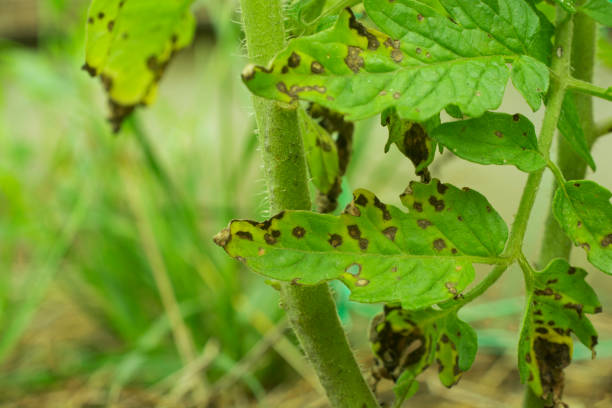
8. Canker
Caused by the Clavibacter michidanensis bacteria, canker can easily kill your plants quickly. Leaves with canker develop large brown spots with brown crispy edges.
Infected leaves will slowly die after wilting, spreading into stems and causing cracks and knots. Unfortunately, there is no known cure or treatment for tomato leaf canker yet.
How You Can Solve It: Preventive Measures
How to prevent canker in tomato leaves:
- Immediately uproot and dispose of your plants safely to avoid further contamination.
- Keep a sharp eye on the other plants in your garden in case of delayed infection.
- Always clean and sanitize all your tools and clothes before and after gardening.
- Mulch your garden properly.
9. Verticillium Wilt
The soil-borne fungus Verticillium dahliae causes older lower leaves to yellow before developing large brown spots. The fungus affects the stems as well as brown streaks or patches.
If left alone, Verticillium Wilt can easily spread to other fruiting plants, trees, shrubs, and even ornamentals. Unfortunately, there is no known treatment for this disease.
How You Can Solve It: Preventive Measures
How to prevent Verticillium Wilt in tomato plants:
- Uproot and dispose of or destroy the infected plants immediately using clean and sterilized tools and clothes.
- Practice good garden hygiene by using clean and sanitized tools and clothes.
- Water the soil correctly instead of the leaves.
- Provide good airflow for your plants.
10. Early Blight
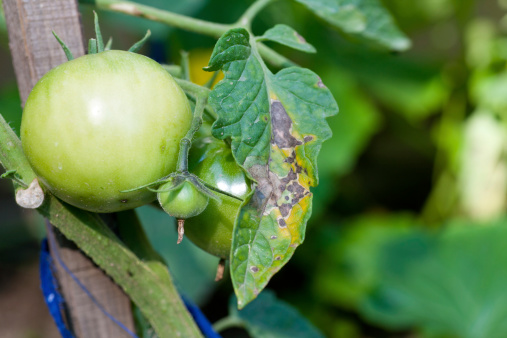
Unlike the previous two diseases, early blight can be treated and prevented. Infected plants will display small dark brown spots caused by the fungus Alternaria solani.
How You Can Solve It: Treatment and Prevention
How to treat early blight in tomato plants:
- Immediately uproot the infected plants with clean sterilized tools and clothing.
- Dispose of the infected plants safely to avoid further spread.
- Clean and sanitize your tools and clothes after.
How to prevent early blight in tomato plants:
- Ensure good gardening hygiene by cleaning and sanitizing your tools and clothing frequently.
- Place mulch around the base of plants to avoid water splashing on the leaves.
- Cage or stake your tomatoes to encourage better airflow.
11. Late Blight
This disease is rarer than early blight as it is caused by another fungus, the Phytophthora infestans. Similar to early blight, leaves display spots all over the leaves.
These spots start out as pale green before turning brown and then eventually black. Late blight affects leaves, stems, and fruits through spots and fuzzy mold growths.
Unfortunately, late blight is untreatable for now.
How You Can Solve It: Prevention
How to prevent late blight in tomato plants:
- Remove and dispose of all infected plants safely.
- Clean and sanitize your tools and clothes after.
- Water the soil correctly to avoid fungal growth.
- Mulch around the base of your plants.
- Encourage better airflow in and between your tomato plants.
Tomato plants are some of the easiest to grow with a huge harvest as a reward at the end of the season. Now that you know how to treat and prevent all the reasons for your tomato leaves turning brown, you can easily resolve any issue without fear!



